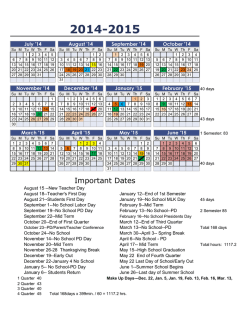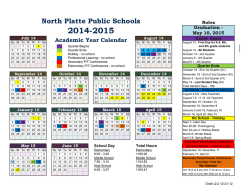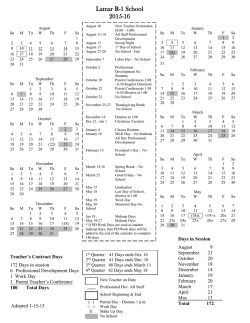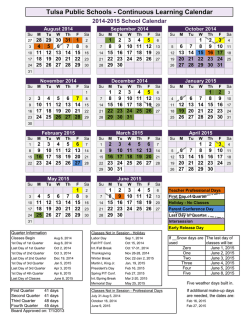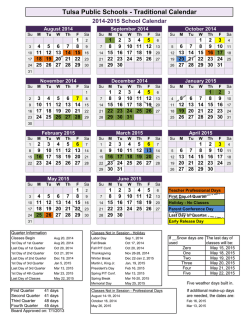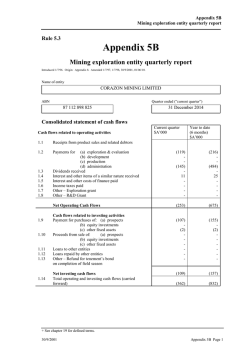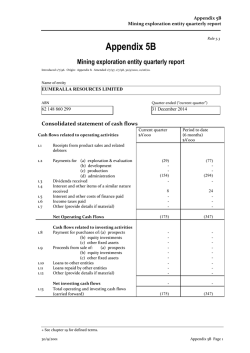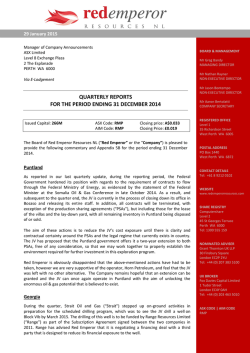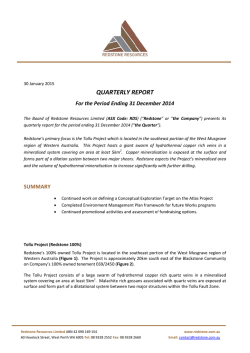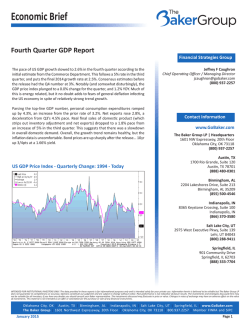
For personal use only
Level 14, 31 Queen Street Melbourne, Victoria 3000 t +61 3 8610 8633 e [email protected] www.aruntaresources.com.au ABN 73 For personal use only 089 224 402 30 January 2015 ASX ANNOUNCEMENT (ASX: AJR) QUARTERLY REPORT FOR THE PERIOD ENDING 31 DECEMBER 2014 Highlights: Development pathway secured for Hatches Creek Tungsten Project by way of a $1.5M farm-in by GWR Group(ASX:GWR), to earn 50%. Initial funds from GWR fund will ensure the completion of definitive metallurgical testwork, and the preparation of a Scoping Study to assess the technical and economic viability of the recovery of tungsten (WO3) from surface mineralisation found in waste dumps, stockpiles and tailings material contained within the Hatches Creek Project area. Preliminary results from metallurgical teat work successfully produced marketable WO3 concentrates, of both Scheelite and Wolframite can be recovered to a concentrate grade of 57.197% WO3 for Treasure and 63.552% WO3 for Pioneer through a simple Rougher Gravity and Magnetic circuit. Further testwork is underway on the remaining concentrates in the cleaner and scavenger circuit materials to determine final concentrate grades and recovery. HATCHES CREEK PROJECT (100% AJR) During the Quarter, Arunta Resources Limited (ASX: AJR) (“Arunta” or “the Company”) secured a near-term development pathway for its Hatches Creek Tungsten Project in the Northern Territory after signing a binding Heads of Agreement with GWR Group Limited (ASX: GWR). Under the agreement, GWR will sole fund $1.5 million of expenditure to earn a 50% interest in Hatches Creek, with the funds to be used to undertake development studies and secure approvals for a mining and processing operation focusing initially on high-grade surface stockpiles. Further metallurgical work is already underway with the initial results successfully producing marketable WO3 concentrates. The agreement with GWR will enable Arunta to realise value from the Hatches Creek Tungsten Project for its shareholders and participate in a near-term production and cash flow opportunity without the need to undertake a dilutive capital raising in the near term. Terms of the Heads of Agreement For personal use only Under the terms of the binding Heads of Agreement (“HoA”) GWR has agreed to sole fund $1.5 million of Joint Venture Expenditure from the execution date to earn a 50% Joint Venture Interest. It is proposed that GWR’s Joint Venture Expenditure will be applied towards a bulk sample work program including: Completion of definitive metallurgical test work (already commenced by Arunta); Preparation of a Scoping Study to assess the technical and economic viability of the recovery of tungsten (WO3) from surface mineralisation found in waste dumps, stockpiles and tailings material contained within the Project area; Obtaining environmental and governmental approval for the Project; Negotiation with traditional owners of the land covered by the Project Tenements; Plant design and engineering studies for site infrastructure; and Contributing towards funding initial mine development requirements, including (but not limited to) roads, tailings storage facility, camp and water supply. If GWR fails to spend $1.5 million of Joint Venture Expenditure in a period of two years from the date the HoA was signed (which may be extended in certain circumstances), it will be deemed to have withdrawn from the HoA without acquiring a Joint Venture Interest. There is no minimum expenditure obligation, however GWR has agreed to meet the cost of certain committed expenditure for metallurgical testwork and to maintain the tenements in good standing. GWR will be the Manager of the Joint Venture. Each of GWR and Arunta will have the right to appoint two persons to a Management Committee that will be responsible for oversight of Joint Venture operations. GWR has been granted a first right of refusal to provide debt finance to the Joint Venture for 100% of the Project on normal commercial terms in order to progress the development of a processing plant at the Project, supported by off-take arrangements with a major trading house or end-user of tungsten concentrates. As the primary objective of the Joint Venture is to develop a commercial operation producing tungsten concentrates from surface mineralisation, the parties have agreed that further exploration shall be undertaken by the Joint Venture once the project is in production and producing free cash flow and as otherwise determined by the Management Committee. Arunta and GWR have agreed to negotiate in good faith and execute a detailed Joint Venture Agreement embodying the principles contained in the HoA. In the meantime the HoA is legally binding upon the parties. Hatches Creek Metallurgical Testwork In October 2014 a bulk sampling program was completed, which involved the collection of three samples representative of the resource zone mineralisation at Pioneer, Green Diamond and Treasure(See f. The samples were collected in 1 tonne bulker bags and dispatched to Nagrom Metallurgical Laboratories in Kelmscott WA. The aim of Nagrom’s test work is to optimise the processing parameters to achieve the best possible recoveries of Wolframite and Scheelite (tungsten) and to determine the specifications of the final concentrates. The bulk samples from Treasure and Pioneer were analyised and results returned consistent head grades of 0.6 - 0.7% WO3, see highlighted results in Table 1 below; Table 1-Bulk sample head grades For personal use only SAMPLE (P100<2mm) Northing (GDA, Z53) Easting (GDA, Z53) WO3 Sn Mo Cu Bi Au Ag % % % % ppm ppm ppm Treasure 7686750 518670 0.622 0.005 0.009 0.022 111 0.165 <0.1 Pioneer 7692140 518660 0.743 0.005 0.010 0.149 1061 0.275 1.5 Gravity Testwork Samples were crushed to P100 2mm and spilt for analysis (Head grades in Table 1). All samples were analysed for WO3, Sn, Fe2O3, MnO, SiO2, Al2O3, TiO2, CaO, MgO, As, P, S, Mo, Cu, Au, Ag, Bi and LOI1000. Samples were then wet screened and separated into +0.5mm and -0.5mm fractions. These two fractions were then sent to spiral separation. Rougher spiral separation produced three fractions from each sample; a Concentrate, a Middling and a Tailing fraction. At each stage of work full analysis and sizing was completed on each fraction. The four fractions (Pioneer ± 0.5mm and Treasure ±0.5mm) were then wet tabled, prior to this spiral concentrate and middling were recombined. Wet tabling produced 5 fractions (or streams); Super-concentrate(See figures 1), Concentrate, Middling, Tailing and Slimes. Figure 1- Scheelite under UV, coming off the wet table. For personal use only The Super-concentrate and Concentrate streams were then subject to magnetic separation into four streams, ie producing eight samples; Mag1 (1000G magnetics), Mag2 (4000G magnetics), Mag3 (12980 & 17000G magnetics) and Non-magnetics, and the results analysed. For an example see figure 2, these are photos of the magnetic fractions Mag1 to Non-Mag. Mag1 contained little to no WO3 , Mag2 and 3 contains visible WO3 (Scheelite and Wolframite) these both require further upgrade via tabling and Non -Mag contains significant visible Scheelite under UV and is a final concentrate. Pioneer -0.5mm Cl Wet Table Superconcentrate 1000G Magnetics Pioneer -0.5mm Cl Wet Table Superconcentrate 4000G Magnetics Pioneer -0.5mm Cl Wet Table Superconcentrate 17000G Magnetics Pioneer -0.5mm Cl Wet Table Superconcentrate 17000G Non Magnetics Pioneer -0.5mm Cl Wet Table Superconcentrate 1000G Magnetics (UV) Pioneer -0.5mm Cl Wet Table Superconcentrate 4000G Magnetics (UV) Pioneer -0.5mm Cl Wet Table Superconcentrate 17000G Magnetics (UV) Pioneer -0.5mm Cl Wet Table Superconcentrate 17000G Non Magnetics (UV) Figure 2 – Pioneer Super-concentrate Microscopy images, under normal light and UV. Preliminary Results The Preliminary Circuit Summary tables are shown below; the products from the primary gravity (spirals and wet tables) and magnetics circuit have been categorised into 4 groups or streams for each bulk sample (See Tables 2 & 3). The cleaner and scavenger circuit material require further treatment to improve grade and recovery to final concentrate specifications Treasure Bulk Sample Final Concentrate - The +0.5mm Super-concentrate Mag2 (4000G Magnetics), -0.5mm Superconcentrate Mag 2(4000G Magnetics) and -0.5mm Super-concentrate Mag 3 (16994G Magnetics). To Cleaner Circuit – The paramagnetic and non-magnetic streams that require cleaner gravity treatment via wet or dry tabling (air tables) to bring up to final concentrate specifications. For personal use only To Scavenger Circuit - Predominantly comprised of the Rougher Spiral Tailings streams and will require further grinding to liberate composite WO3 grains, it is anticipated this material will go back into the spiral circuit post-grind. Final Tailings –Cleaner gravity tailings and Ferromagnetic fractions that contain little or no WO3 Table 2 – Treasure Circuit Summary Circuit Summary PRODUCT Yield WO3 Cu Bi Au % % dist. % dist. ppm dist. ppm dist. Final Concentrate 0.14% 57.197 13.48% 0.192 1.39% 587 0.92% 0.193 0.76% To Cleaner Circuit To Scavenger Circuit Final Tailings 3.13% 8.49 43.53% 0.103 16.16% 431 14.76% 0.148 12.69% 86.08% 0.28 39.52% 0.018 75.99% 83 77.90% 0.036 83.69% 10.65% 0.199 3.47% 0.012 6.46% 55 6.41% 0.01 2.86% Calculated Head 100.00% 0.61 100.00% 0.02 100.00% 91 100.00% 0.037 100.00% Pioneer Bulk sample Final Concentrate - The -0.5mm Super-concentrate non-magnetic fraction ( see Figure 2 images on the right). To Cleaner Circuit – The paramagnetic and non-magnetic streams that will require cleaner gravity treatment via wet or dry tabling (air tables) to bring up to final concentrate specifications. To Scavenger Circuit - Predominantly comprised of the Rougher Spiral Tailings streams and will require further grinding to liberate composite WO3 grains, it is anticipated this material will go back into the spiral circuit post-grind. Final Tailings – Cleaner gravity tailings and Ferromagnetic fractions that contain little or no WO3 . Table 3 – Pioneer Circuit Summary Circuit Summary PRODUCT Yield % % dist. % dist. ppm dist. ppm dist. Final Concentrate 0.20% 63.552 15.64% 0.193 0.27% 50600 10.63% 8.63 5.67% To Cleaner Circuit To Scavenger Circuit Final Tailings 6.41% 7.098 55.82% 0.746 33.29% 3544 23.78% 0.885 18.60% 75.59% 0.284 26.31% 0.112 59.02% 749 59.24% 0.257 63.61% 17.80% 0.102 2.24% 0.06 7.42% 341 6.35% 0.208 12.11% 100.00% 0.815 100.00% 0.144 100.00% 955 100.00% 0.305 100.00% Calculated Head WO3 Cu Bi Au Further Work Underway For personal use only The testwork completed to date has demonstrated that coarse grained (P100 2mm) Scheelite and Wolframite can be recovered at a grade of 57.197% WO3 for Treasure and 63.552% WO3 for Pioneer through a simple Rougher Gravity and Magnetic circuit. Scheelite and gold concentrated well in the non magnetic fraction at Pioneer. Cleaner Gravity treatment will focus on the upgrade of the “To Cleaner Circuit” streams to generate additional marketable concentrate. At both Treasure and Pioneer over 55% of the contained WO3 lie within the final concentrate and cleaner streams. The next stage of testwork is underway and is investigating the potential for scavenging unliberated WO3 from the Rougher Gravity Tailing streams. The material to go to the scavenger circuit totals 39.52% of the contained WO3 (See tables 2& 3) and 26.31% of the contained WO3 at Treasure and Pioneer, respectively. The “To Scavenger Circuit” streams will be milled to liberate composite WO3 grains and will proceed to further gravity and magnetic treatment. The processing parameter will be optimised to achieve the best possible recoveries of tungsten and determine the specifications of the final tungsten concentrate. This information will be circulated to prospective buyers of the Tungsten concentrates to obtain indications of the likely concentrate sale price. Nagrom will also optimise the processing flow sheet and plant design for costing into a Scoping Study. Figure 3 – Main Groups of Historical Mine areas at Hatches Creek For personal use only SOUTHERN CROSS BORE PROJECT (AJR 100%) No field work was completed at Southern Cross Bore during the December quarter. Arunta is planning downhole EM at the Johnnies Reward prospect to further define drill targets derived from a recent VTEM helimag survey (ASX RELEASE 13 MARCH 2014: FOUR PRIORITY IOCG TARGET AREAS DERIVED FROM SXB VTEM PLUS HELIMAG SURVEY). Johnnies Reward is a high grade gold/copper magnetite skarn which plunges north east into the southern end of a two plus kilometre long sheared and deeply weathered lithological contact which hosts significant anomalous base metal and precious metal mineralisation. Johnnies Reward has been defined as hosting IOCG style mineralisation and the host shear structure is considered prospective for discovery of multiple IOCG style deposits below the base of oxidation. CORPORATE The Company held its 2014 Annual General Meeting on 26 November 2015. All resolutions were passed without amendment. Figure 4 – Arunta’s Project Location Map ~ END ~ For further information: Investors: For personal use only Neil Biddle, Director Arunta Resources Limited Tel: +61 (0)418 915 752 The company confirms it is not aware of any new information or data that materially affects the information included in the September 23rd , 2014 Hatches Creek Mineral Resource Estimate and that all material assumptions and technical parameters underpinning the estimate continue to apply and have not materially changed when referring to its maiden resource announcement made on 23 rd September. Competent Person Statement: The information in this report that relates to Exploration Results is based on and fairly represents information and supporting documentation prepared by Mr Neil Biddle (A Director of Arunta Resources Limited). Mr Biddle is a shareholder of Arunta Resources Limited. Mr Biddle is a Corporate Member of the Australasian Institute of Mining and Metallurgy and has sufficient experience of relevance to the styles of mineralisation and types of deposits under consideration, and to the activities undertaken to qualify as Competent Persons as defined in the 2012 Edition of the Joint Ore Reserves Committee (JORC) Australasian Code for Reporting of Exploration Results, Mineral Resources and Ore Reserves. Specifically, Mr Biddle consents to the inclusion in this report of the matters based on his information in the form and context in which they appear. JORC Code, 2012 Edition – Table 1 report For personal use only Section 1 Sampling Techniques and Data Criteria Sampling techniques JORC Code explanation Nature and quality of sampling (eg cut channels, random chips, or specific specialised industry standard measurement tools appropriate to the minerals under investigation, such as down hole gamma sondes, or handheld XRF instruments, etc). These examples should not be taken as limiting the broad meaning of sampling. 3 Bulk Samples were taken as cut channels on Mullock dumps. Bulk samples were approximately 500kg in weight All samples were individually labelled and documented Include reference to measures taken to ensure sample representivity and the appropriate calibration of any measurement tools or systems used. Bulk Mullock samples were taken perpendicular across general trend of the dump over distance of 1 to 3m. Aspects of the determination of mineralisation that are Material to the Public Report. In cases where ‘industry standard’ work has been done this would be relatively simple (eg ‘reverse circulation drilling was used to obtain 1 m samples from which 3 kg was pulverised to produce a 30 g charge for fire assay’). In other cases more explanation may be required, such as where there is coarse gold that has inherent sampling problems. Unusual commodities or mineralisation types (eg submarine nodules) may warrant disclosure of detailed information. Drilling techniques Commentary Drill type (eg core, reverse circulation, open-hole hammer, rotary air blast, auger, Bangka, sonic, etc) and details (eg core diameter, triple or standard tube, depth of diamond tails, face- Samples were crushed to P100 2mm and spilt for analysis Samples was wet screened and separated into a coarse + 0.5mm and fines -0.5mm fraction, dried and riffle split with small 0.1kg taken from each sized fraction for analysis. Each +0.5mm and -0.5mm sized fraction from each of the two bulk sdamples were then subject to wet rougher spiral separation and wet gravity separation on a Wilfley Tables to produce individual concentrate and tails samples . These samples were subject to magnetic separation. All samples were be analysed for WO3, Sn, Fe2O3, MnO, SiO2, Al2O3, TiO2, CaO, MgO, As, P, S, Mo, Cu, Au, Ag, Bi and LOI1000., using XRF. No Drilling was used to collect these samples For personal use only Criteria Drill sample recovery Logging Sub-sampling techniques and sample preparation JORC Code explanation sampling bit or other type, whether core is oriented and if so, by what method, etc). Method of recording and assessing core and chip sample recoveries and results assessed. Commentary No Drilling was used to collect these samples Measures taken to maximise sample recovery and ensure representative nature of the samples. Whether a relationship exists between sample recovery and grade and whether sample bias may have occurred due to preferential loss/gain of fine/coarse material. No Drilling was used to collect these samples Whether core and chip samples have been geologically and geotechnically logged to a level of detail to support appropriate Mineral Resource estimation, mining studies and metallurgical studies. Whether logging is qualitative or quantitative in nature. Core (or costean, channel, etc) photography. The total length and percentage of the relevant intersections logged. If core, whether cut or sawn and whether quarter, half or all core taken. If non-core, whether riffled, tube sampled, rotary split, etc and whether sampled wet or dry. For all sample types, the nature, quality and appropriateness of the sample preparation technique. Quality control procedures adopted for all sub-sampling stages to maximise representivity of samples. Measures taken to ensure that the sampling is representative of the in situ material collected, including for instance results for field duplicate/second-half sampling. No Drilling was used to collect these samples Geology was logged by geologist and located by using a hand held GPS Descriptions exist for all samples in the database Sample descriptions are has primarily been quantitative and contain some components of semi-quantitative analysis Photographs of sample sites are available. Estimated No Drilling was used to collect these samples. Sub samples were taken, and riffle split there was no preparation of sample on site. At each stage of the metallurgical process, sub samples were taken and assayed. No duplicates were taken. For personal use only Criteria Quality of assay data and laboratory tests Verification of sampling and assaying JORC Code explanation Commentary Whether sample sizes are appropriate to the grain size of the material being sampled. Samples were a minimum of 500kg. These are appropriate for this scale of testwork. The nature, quality and appropriateness of the assaying and laboratory procedures used and whether the technique is considered partial or total. No Assays completed at this stage. For geophysical tools, spectrometers, handheld XRF instruments, etc, the parameters used in determining the analysis including instrument make and model, reading times, calibrations factors applied and their derivation, etc. Nature of quality control procedures adopted (eg standards, blanks, duplicates, external laboratory checks) and whether acceptable levels of accuracy (ie lack of bias) and precision have been established. The verification of significant intersections by either independent or alternative company personnel. No geophysical tools were used to determine any element concentrations. Assaying was completed by Nagrom Pty Ltd an established ISO verified laboratory, with quality control procedures. No field duplicates were submitted in this sample program Sample information is recorded at the time in hard copy format The use of twinned holes. Documentation of primary data, data entry procedures, data verification, data storage (physical and electronic) protocols. Discuss any adjustment to assay data. An electronic database containing collars, surveys, assays and geology will be complied into the company’s database. Data verification was undertaken by checking assays and collars against hard copy logs. No adjustment has been required Accuracy and quality of surveys used to locate drill holes (collar and down-hole surveys), trenches, mine workings and other locations used in Mineral Resource estimation. Sample locations have been surveyed by handheld GPS only. Location of data points For personal use only Criteria JORC Code explanation Commentary Specification of the grid system used. Quality and adequacy of topographic control. Data spacing for reporting of Exploration Results. Grab or bulk samples representivity cannot be assessed as they are localized samples. Whether the data spacing and distribution is sufficient to establish the degree of geological and grade continuity appropriate for the Mineral Resource and Ore Reserve estimation procedure(s) and classifications applied. Whether sample compositing has been applied. Sample space is not sufficient, material sampled is local in nature, and not continuous with regard to geology. No compositing at this stage. Whether the orientation of sampling achieves unbiased sampling of possible structures and the extent to which this is known, considering the deposit type. The sample orientations are deemed appropriate. No orientation-based sampling bias has been identified. Sample security If the relationship between the drilling orientation and the orientation of key mineralised structures is considered to have introduced a sampling bias, this should be assessed and reported if material. The measures taken to ensure sample security. Audits or reviews The results of any audits or reviews of sampling techniques and data. No Audits or reviews have been completed Data spacing and distribution Orientation of data in relation to geological structure The GPS locations were recored MGA (GDA94, Zone 53) coordinates. No topographic control Chain of custody for samples were managed by Arunta personnel. Samples were delivered to Nagrom laboratory by freight company. 1. Section 2 Reporting of Exploration Results For personal use only (Criteria listed in the preceding section also apply to this section.) Criteria Mineral tenement and land tenure status Exploration done by other parties Geology JORC Code explanation Type, reference name/number, location and ownership including agreements or material issues with third parties such as joint ventures, partnerships, overriding royalties, native title interests, historical sites The security of the tenure held at the time of reporting along with any known impediments to obtaining a licence to operate in the area. Commentary Exploration Licences 22912 and 23462 are 100% are held by Davenport Resources Limited a 100% owned subsidiary of Arunta Resources Limited. Acknowledgment and appraisal of exploration by other parties. Thor Mining PLC, were the last company to explore the area in 2008. Deposit type, geological setting and style of mineralisation. The Hatches Creek tenements are underlain by Palaeoproterozoic sequence of weakly metamorphosed clastic sedimentary and felsic volcanic rocks. The sequence is intruded by igneous sills. Sandstone is the dominant sedimentary lithology. The sequence has been subjected to folding and faulting and has been cut by numerous narrow quartz reefs which follow lines of shearing. The quartz reefs are mineralised, the main mineral of economic interest being wolframite, although bismuth, gold and copper mineralisation is also present within them. The average tungsten grade of the mined reefs was between 1% and 5% WO3. All statutory approvals have been acquired to conduct exploration. No known impediments. The mineralised reefs are present in groups. The average reef width is 30cm, with the maximum width being 1.5m. The maximum strike length of any one reef is around 170m however en echelon lines of reefs are up to 1.5km in length. The reefs strike in two main directions, just east of north, parallel to the main fault direction, and east-northeast. The north-striking reefs dip at moderate to steep angles either to the west or the east; those striking easterly dip at moderate to steep angles to the south. The majority of the reefs are within volcanic or intrusive rocks, rather than in the sandstone units. The more mafic host rocks For personal use only Criteria Drill hole Information Data aggregation methods Relationship between mineralisation widths and intercept lengths Diagrams JORC Code explanation A summary of all information material to the understanding of the exploration results including a tabulation of the following information for all Material drill holes: o easting and northing of the drill hole collar o elevation or RL (Reduced Level – elevation above sea level in metres) of the drill hole collar o dip and azimuth of the hole o down hole length and interception depth o hole length. If the exclusion of this information is justified on the basis that the information is not Material and this exclusion does not detract from the understanding of the report, the Competent Person should clearly explain why this is the case. In reporting Exploration Results, weighting averaging techniques, maximum and/or minimum grade truncations (eg cutting of high grades) and cut-off grades are usually Material and should be stated. Where aggregate intercepts incorporate short lengths of high grade results and longer lengths of low grade results, the procedure used for such aggregation should be stated and some typical examples of such aggregations should be shown in detail. The assumptions used for any reporting of metal equivalent values should be clearly stated. These relationships are particularly important in the reporting of Exploration Results. If the geometry of the mineralisation with respect to the drill hole angle is known, its nature should be reported. If it is not known and only the down hole lengths are reported, there should be a clear statement to this effect (eg ‘down hole length, true width not known’). Appropriate maps and sections (with scales) and tabulations of intercepts should be included for any significant discovery Commentary (gabbro, diorite) appear to have been important host rocks for some of the significant mineralisation in the area. No Drilling conducted No weighting techniques have been used all results have been reported Where results have been discussed, a simple arithmetic average has been used. Results are from bulk samples, no geometry or width are able to be reported. See Figures 1 For personal use only Criteria Balanced reporting Other substantive exploration data Further work JORC Code explanation being reported These should include, but not be limited to a plan view of drill hole collar locations and appropriate sectional views. Where comprehensive reporting of all Exploration Results is not practicable, representative reporting of both low and high grades and/or widths should be practiced to avoid misleading reporting of Exploration Results. Other exploration data, if meaningful and material, should be reported including (but not limited to): geological observations; geophysical survey results; geochemical survey results; bulk samples – size and method of treatment; metallurgical test results; bulk density, groundwater, geotechnical and rock characteristics; potential deleterious or contaminating substances. The nature and scale of planned further work (eg tests for lateral extensions or depth extensions or large-scale stepout drilling). Diagrams clearly highlighting the areas of possible extensions, including the main geological interpretations and future drilling areas, provided this information is not commercially sensitive. Commentary All results have been reported Description of sample type and size has been reported, bulk samples were 5-24kg. Rock chips were 0.5 to 1.7kg Further metallurgical testing of samples are required. For personal use only Appendix 5B Mining exploration entity and oil and gas exploration entity quarterly report Rule 5.5 For personal use only Appendix 5B Mining exploration entity and oil and gas exploration entity quarterly report Introduced 01/07/96 Origin Appendix 8 Amended 01/07/97, 01/07/98, 30/09/01, 01/06/10, 17/12/10, 01/05/2013 Name of entity ARUNTA RESOURCES LIMITED Quarter ended (“current quarter”) ABN 73 089 224 402 31 DECEMBER 2014 Consolidated statement of cash flows Cash flows related to operating activities 1.1 Receipts from product sales and related debtors 1.2 Payments for 1.3 1.4 1.5 1.6 1.7 (a) exploration & evaluation (b) development (c) production (d) administration Dividends received Interest and other items of a similar nature received Interest and other costs of finance paid Income taxes paid Other – rental and office service income - Research & development claim Net Operating Cash Flows 1.8 1.9 1.10 1.11 1.12 1.13 Cash flows related to investing activities Payment for purchases of: (a) prospects (b) equity investments (c) other fixed assets Proceeds from sale of: (a) prospects (b) equity investments (c) other fixed assets Loans to other entities Loans repaid by other entities Other (provide details if material) Net investing cash flows Total operating and investing cash flows (carried forward) + See chapter 19 for defined terms. 01/05/2010 Appendix 5B Page 1 Current quarter $A’000 64 Year to date (6 months) $A’000 64 (92) (242) - (109) (508) - 5 24 284 7 70 284 43 (192) - - - - 43 (192) Appendix 5B Mining exploration entity and oil and gas exploration entity quarterly report For personal use only 1.13 1.14 1.15 1.16 1.17 1.18 1.19 Total operating and investing cash flows (brought forward) 43 (192) Cash flows related to financing activities Proceeds from issues of shares, options, etc. Proceeds from sale of forfeited shares Proceeds from borrowings Repayment of borrowings Dividends paid Other – capital raising costs - 1,096 (87) Net financing cash flows - 1,009 43 817 Net increase (decrease) in cash held 1.20 1.21 Cash at beginning of quarter/year to date Exchange rate adjustments to item 1.20 918 - 144 - 1.22 Cash at end of quarter 961 961 Payments to directors of the entity, associates of the directors, related entities of the entity and associates of the related entities Current quarter $A'000 1.2 Aggregate amount of payments to the parties included in item 1.2 3 1.2 Aggregate amount of loans to the parties included in item 1.10 4 1.2 Explanation necessary for an understanding of the transactions 5 66 - Wages or consultancy fees paid to directors and director related entities during the quarter. Non-cash financing and investing activities 2.1 Details of financing and investing transactions which have had a material effect on consolidated assets and liabilities but did not involve cash flows Nil 2.2 Details of outlays made by other entities to establish or increase their share in projects in which the reporting entity has an interest Nil + See chapter 19 for defined terms. Appendix 5B Page 2 01/05/2013 Appendix 5B Mining exploration entity and oil and gas exploration entity quarterly report Financing facilities available For personal use only Add notes as necessary for an understanding of the position. 3.1 Loan facilities 3.2 Credit standby arrangements Amount available $A’000 Amount used $A’000 - - - - Estimated cash outflows for next quarter $A’000 4.1 Exploration and evaluation 4.2 Development 4.3 Production 4.4 Administration 50 260 Total 310 Reconciliation of cash Reconciliation of cash at the end of the quarter (as shown in the consolidated statement of cash flows) to the related items in the accounts is as follows. Current quarter $A’000 Previous quarter $A’000 911 868 5.1 Cash on hand and at bank 5.2 Deposits at call 50 50 5.3 Bank overdraft - - 5.4 Other (provide details) - - 961 918 Total: cash at end of quarter (item 1.22) Changes in interests in mining tenements and petroleum tenements Tenement reference and location 6.1 Interests in mining tenements and petroleum tenements relinquished, reduced or lapsed 6.2 Interests in mining tenements and petroleum tenements acquired or increased + See chapter 19 for defined terms. 01/05/2010 Appendix 5B Page 3 Nature of interest (note (2)) Interest at beginning of quarter Interest at end of quarter Appendix 5B Mining exploration entity and oil and gas exploration entity quarterly report Issued and quoted securities at end of current quarter Description includes rate of interest and any redemption or conversion rights together with prices and dates. For personal use only Total number 7.1 7.2 7.3 7.4 7.5 7.6 7.7 7.8 7.9 7.10 7.11 7.12 Preference +securities (description) Changes during quarter (a) Increases through issues (b) Decreases through returns of capital, buy-backs, redemptions +Ordinary securities Changes during quarter (a) Increases through issues (b) Decreases through returns of capital, buy-backs +Convertible debt securities (description) Changes during quarter (a) Increases through issues (b) Decreases through securities matured, converted Options (description and conversion factor) Issued during quarter Exercised during quarter Expired during quarter Debentures (totals only) Unsecured notes (totals only) Number quoted Issue price per security (see note 3) (cents) Amount paid up per security (see note 3) (cents) 1,826,956,020 1,826,956,020 30,000,000 15,000,000 590,586,829 590,586,829 Exercise price 2.0 3.0 0.2 Expiry date 21/03/2015 18/12/2016 31/07/2019 246,354,457 246,354,457 2.0 20/12/2014 + See chapter 19 for defined terms. Appendix 5B Page 4 01/05/2013 Appendix 5B Mining exploration entity and oil and gas exploration entity quarterly report For personal use only Compliance statement 1 This statement has been prepared under accounting policies which comply with accounting standards as defined in the Corporations Act or other standards acceptable to ASX (see note 5). 2 This statement does give a true and fair view of the matters disclosed. 30 January 2015 Sign here: ............................................................ Date: ............................ Company Secretary ADRIEN WING Print name: ......................................................... Notes 1 The quarterly report provides a basis for informing the market how the entity’s activities have been financed for the past quarter and the effect on its cash position. An entity wanting to disclose additional information is encouraged to do so, in a note or notes attached to this report. 2 The “Nature of interest” (items 6.1 and 6.2) includes options in respect of interests in mining tenements and petroleum tenements acquired, exercised or lapsed during the reporting period. If the entity is involved in a joint venture agreement and there are conditions precedent which will change its percentage interest in a mining tenement or petroleum tenement, it should disclose the change of percentage interest and conditions precedent in the list required for items 6.1 and 6.2. 3 Issued and quoted securities The issue price and amount paid up is not required in items 7.1 and 7.3 for fully paid securities. 4 The definitions in, and provisions of, AASB 6: Exploration for and Evaluation of Mineral Resources and AASB 107: Statement of Cash Flows apply to this report. 5 Accounting Standards ASX will accept, for example, the use of International Financial Reporting Standards for foreign entities. If the standards used do not address a topic, the Australian standard on that topic (if any) must be complied with. == == == == == + See chapter 19 for defined terms. 01/05/2010 Appendix 5B Page 5 Appendix 5B Mining exploration entity and oil and gas exploration entity quarterly report Arunta Resources Ltd Tenement schedule for the quarter ending December 2014 For personal use only NORTHERN TERRITORY Title Number EL 28045 EL 29062 EL 22912 EL 23463 EL 29827 EL 30090 Registered Holder Davenport Resources Limited Davenport Resources Limited Davenport Resources Limited Davenport Resources Limited Davenport Resources Limited Davenport Resources Limited Interest held at start of quarter Change in interest during the quarter Interest held at end of quarter Renewal Date Annual Exp Req Status (G Grant, A Applcn) Area sq kms 100 Nil 100 30/11/2014 161,000 G 73 100 Nil 100 A 61 100 Nil 100 25/08/2014 43,125 G 25 100 Nil 100 25/08/2014 42,550 G 6 100 Nil 100 29/08/2014 10,750 G 16 100 Nil 100 A 557 No changes during the quarter == == == == + See chapter 19 for defined terms. Appendix 5B Page 6 01/05/2013
© Copyright 2026
